The Threats to the Redwoods
The threats to the redwoods have grown increasingly complex, and the League’s work to protect, restore and connect people with redwood forests is more important than ever.
The threats to the redwoods have grown increasingly complex, and the League’s work to protect, restore and connect people with redwood forests is more important than ever.
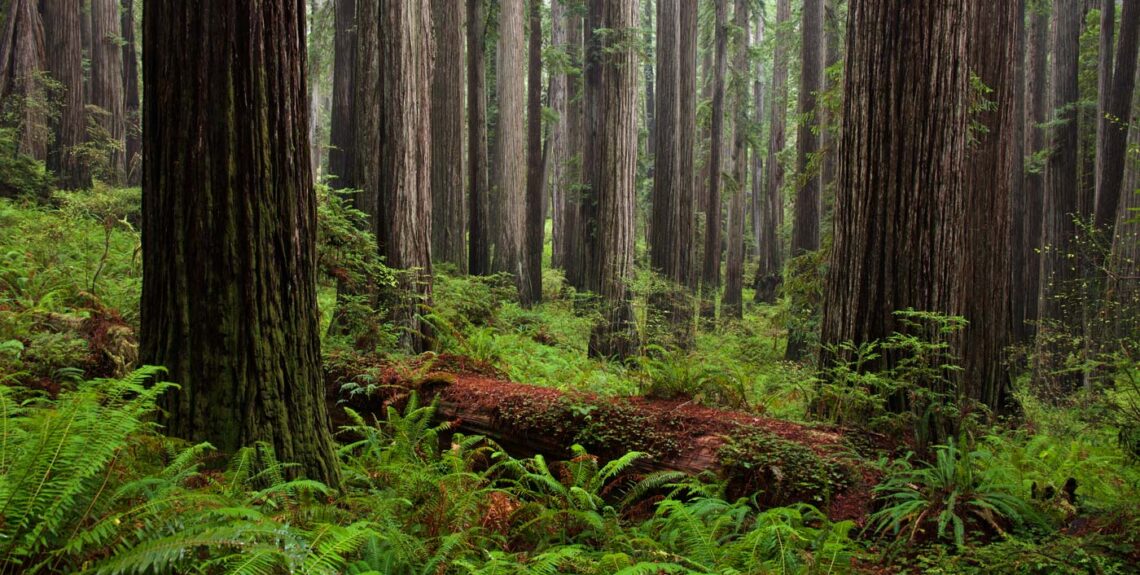
When Save the Redwoods League was founded in 1918, the redwood forest was being felled at an alarming rate. Dismayed by vast clear-cuts scarring the primeval forests, the League’s founders set in motion our legacy of buying forestland for permanent protection. Thanks to our members’ support, the League has succeeded in preserving more than 200,000 acres in dozens of redwoods parks for everyone to enjoy.
With your help, the League still acts to protect the ancient redwood forest from logging. But today, the threats to the redwood forest are increasingly complex, no longer embodied simply by the axe and saw.
Some of the modern-day threats to redwoods include climate change; human land uses not compatible with forest health (such as development and conversion to vineyards); intense fires; people’s increasing detachment from nature; illegal marijuana cultivation; and burl poaching. These issues imperil the forests we all love, and it is critical that we take wise action now to protect the redwoods for future generations.
The League’s work to protect, restore and connect people with redwood forests is more important than ever. What we do today will help to ensure that the forest has the best chance of thriving into the future. Continue reading to learn more about the threats to the redwoods and what the League is doing to help.
Throughout their ranges, the redwoods and sequoias are being subjected to the effects of climate change: temperature increases, less coastal fog, reductions in snowpack and earlier annual snowmelt.
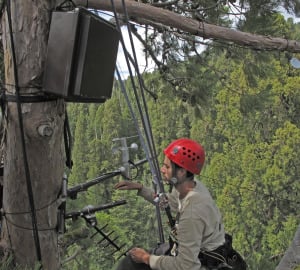
Climate change will interact with other stressors that the redwoods had never experienced until recently. In addition to the extensive logging that began with the 1849 gold rush, leaving a small fraction of the original coast redwood forest, humans have introduced other stressors to the redwood forest including invasive species, fire suppression, air pollution and habitat fragmentation.
Climate change, and its current and projected interactions with these stressors, jeopardizes the redwoods’ ability to survive and thrive into the future. We don’t know yet precisely how climate change will impact the redwood forest, but we must act today to protect redwoods from future threats.
The League is addressing climate change threats by protecting and restoring redwood forestland throughout its natural ranges, and by closely studying the impacts of climate change on the redwoods so that we can identify where climate impacts are most severe and help lessen the stress through informed land management.
From individual trees to whole forests, the Redwoods and Climate Change Initiative (RCCI) is studying redwoods’ growth, vulnerabilities, early indicators of stress and how these trees might respond to predicted climate changes. We are conducting studies in various locations, because we know that climate change impacts will affect different sites in different ways — some places may become more favorable for redwoods, while some may become less so.
Redwood forestland protection throughout the redwoods’ ranges helps buffer the redwoods from environmental changes, and increases the odds of their survival in various climate-change scenarios. The more land is protected, the better their chances of survival.
Old-growth redwood forests store three to ten times more carbon than any other forest on Earth, making them a huge asset in the fight against climate change. Restoring redwood forests — accelerating development of old-growth characteristics — increases their carbon sequestration and storage abilities.
You can help by supporting the Redwoods and Climate Change Initiative today.
Through land conversion, redwood forestland is cleared and converted to another use, often as a real estate development or vineyards.
When redwood forestland is converted, the forest habitat is removed. Of the original redwood range, about a quarter — approximately 625,000 acres — has been lost forever to land conversion. Already occupying a limited area, we cannot afford to lose more of the redwood forest to land conversion.
In addition, when the redwood forest is fragmented due to land conversion, the health of the remaining forestland is compromised. Studies show that biodiversity — the number of species in a given area — decreases significantly in fragmented forests. To thrive, large contiguous tracts of the redwood forest must remain intact.
Since our founding in 1918, the League has purchased redwood forests and surrounding lands to ensure their permanent protection from the threat of conversion. The League also acquires conservation easements or agreements, which grant us the legal right to safeguard the forest from harmful land use practices forever. This way, even if the land remains in private ownership, it can never be converted. Our Vibrant Forest Plan guides our efforts to acquire and protect redwood forestland: Using theory and principles of conservation biology, the Vibrant Forest Plan helps us identify those areas where land protection is most critical.
Your generous support of the League makes it possible for us to preserve the redwood forests we all love.
Fire is a natural and necessary part of both the coast redwood and giant sequoia landscapes. When occurring frequently and at low or moderate intensity, fire sustains the health of these forests by preventing overcrowding of trees and understory vegetation; recycling nutrients; stimulating seedling germination in giant sequoia and other plants; and creating habitat features needed by wildlife for shelter.
Unsurprisingly, given the drought, 2015 proved to be an intense fire year in California. Between January 1 and September 12, 2015, California had 5,225 fires that burned well over 200,000 acres, mostly in Northern California. This is 43% more fires than average for the past five years.
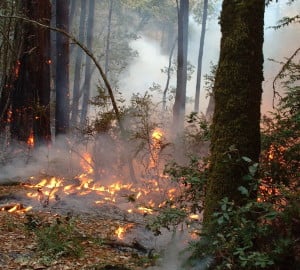
Decades of climate warming and forest fire suppression policies are exacerbating fire intensity. Droughts make fire more likely to ignite and spread through vast landscapes of forest that, in many cases, have not burned for decades due to fire exclusion and therefore carry high fuel loads of small trees and understory vegetation that burn hot once lit. In contrast to the “cool” and moderate fires that sustain the redwood forest, hot and intense fires are more likely to destroy forests and kill even the biggest, most resilient redwoods and giant sequoias.
To revitalize coast redwood and giant sequoia forests and make them resistant to catastrophic fires, we need to study the most effective methods for reintroducing healthy fires into the landscape. It is critical to invest in forest stewardship to lower fuel loads, maintain fuelbreaks in areas at risk of catastrophic fire, maintain road infrastructure to enable good forest management and firefighting, and reintroduce fire by prescription or emulate fire’s positive effects through mechanical vegetation control. Adaptive fire policy that provides for human safety while allowing the necessary stewardship of coast redwood and giant sequoia forests is also crucial.
League researchers and staff study and monitor coast redwood and giant sequoia forests to determine where wildfire intervention is needed. We reduce the fuel load on League-owned properties by clearing overgrowth and conducting prescribed burns as part of an overall ecological restoration strategy. The League also advocates for a policy shift away from fire exclusion. An adaptive policy that allows for the natural fire regime to be more closely replicated will lower the risk of huge, hot fires and leave both human and natural communities safer and healthier.
You can help by supporting the League’s forest restoration work, being an advocate for an adaptive fire policy (external link), and taking care to help prevent accidental fires (external links) from starting.
We live in an era of urbanization and technology, and with the tremendous benefits these advances bring, they may also be facilitating an increasing detachment from nature. Much more than previous generations, today’s children are growing up without outdoor play and recreation. Kids in the United States spend only 1 percent of their time outdoors and 27 percent of their time in front of a screen. Of Americans age 6 and up, less than half participate in outdoor recreation at all.
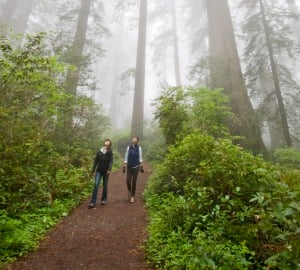
Experiences outdoors enrich our lives, making us happier and healthier. Research shows that spending time in nature enhances the ability to cope with and recover from stress, illness and injury. People consistently report lower anxiety, better attention and increased well-being after spending time outdoors, where parks and open spaces provide beautiful places to exercise and unwind. The benefits to society of a vibrant connection with the outdoors are proven, and if we let this connection fade, we lose the inspiration, health and happiness that results from being in nature. In addition, people protect what they know and love. If we become detached from nature, our environment loses its stewards and caretakers.
The majestic redwoods provide a breathtaking outdoor experience and an accessible gateway to nature for people of all ages and abilities. The League is working to connect more people with our fantastic redwoods parks. The more people we introduce to these places, the healthier and happier our communities will be.
The League’s Education Program connects new generations to the redwood forest. Guided by our Education Committee, the League supports and provides innovative education and interpretation programs that encourage people of all backgrounds and ages to protect redwoods. By partnering with various organizations, the League continues to expand the range and reach of personally relevant redwood experiences to our growing and diverse population. The Education Program has brought more than 190,000 kids and adults into the redwood forest since its inception in 2000.
You can help connect people with the magic of the redwoods by supporting the League’s work today.
Marijuana is a major cash crop in California. The acreage dedicated to marijuana in Humboldt, Mendocino and Trinity counties (the “Emerald Triangle”) is estimated to have doubled in the past five years. The sites most appealing for illegal farms are wooded areas far from roads or towns — generally, parks and protected lands. It’s estimated that 60 percent of the marijuana seizures that come from California were grown on public land.
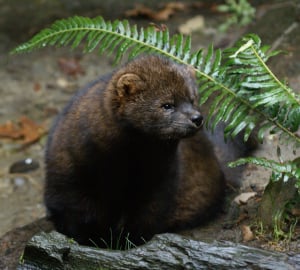
The multitude of “trespass grows” in California causes rampant damage to redwood forests and other landscapes chiefly through the unregulated use of pesticides, rodenticides and water diversion.
The growers redirect waterways to their farms, causing serious problems for wildlife like endangered coho salmon and diverting a precious resource in an already drought-stricken region.
To protect their plants, marijuana growers use rodenticides, a class of chemicals designed to poison rats and mice. Rodenticides are slow-acting, meaning the rodents accumulate the toxins in their bodies for days after consuming the poison, until they are eventually killed. Because rodenticides do not kill immediately, the toxicity easily spreads through the food chain when predators consume poisoned prey.
In the redwood region of Northern California, there have been numerous documented cases of rodenticide-caused deaths of Pacific fishers (a candidate for endangered status), Northern spotted owls (threatened), black bears and other species.
Researchers, parks staff and other experts believe the extent of environmental damage from marijuana farms is vast, though due to their clandestine nature, the precise extent is unknown. In addition to environmental devastation, the armed people guarding the grow sites threaten the safety of those out to enjoy our public lands.
This is a complex issue with no straightforward solution, yet given the serious threats to our water, landscapes and wildlife, it is critical that we work to address it. The League is informing the public of the problem and advocating for the bipartisan Protecting Lands Against Narcotics Trafficking (PLANT) Act. The bill, introduced by Congressman Jared Huffman, would prohibit and penalize marijuana cultivation and related offenses — like causing environmental harm and creating hazards to people and wildlife — on federal land.
Redwood burls are large natural protrusions prized for their intricately patterned wood that can weigh hundreds of pounds and bring thousands of dollars. The burls are most prolific on the oldest trees, and being full of stem cells, they play a critical role in the regeneration of coast redwoods.
Burl poaching involves the illegal cutting, often with chainsaws, of burls from live and dead trees.
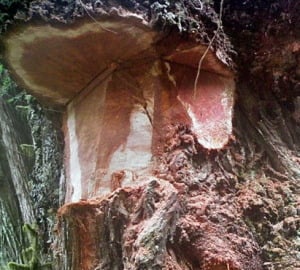
Removing burls exposes redwoods’ vulnerable heartwood to further damage, may deny the tree its primary means of reproduction, and results in the felling of redwood trees to access burls higher up the trunks.
Many of the remaining old-growth redwoods — and their highly valued burls — live within protected park boundaries in California. Burl poaching not only scars our prized redwood parks, but may have lasting impacts on wildlife, including threatened and endangered species. Old-growth redwoods provide rare and critical habitat, and when the trees are cut down for their burls, that rare habitat is lost for the species that depend upon it, such as the marbled murrelet.
The League, with the Center for Biological Diversity and the Redwood Parks Association, has offered a $5,000 reward for information leading to the prosecution of burl poachers. Education can help curb the demand for burl wood, and the League has taken a leadership role in informing the public of this issue.